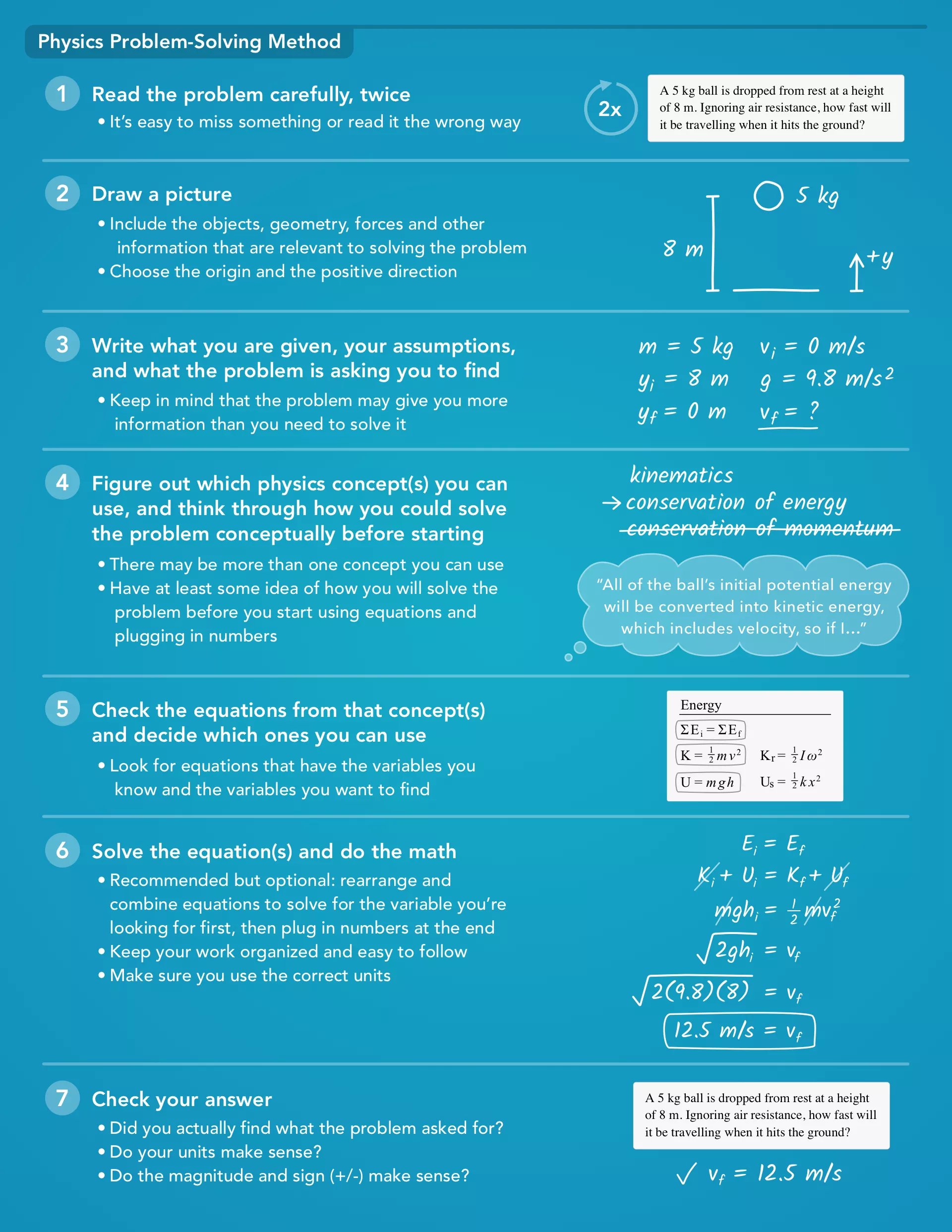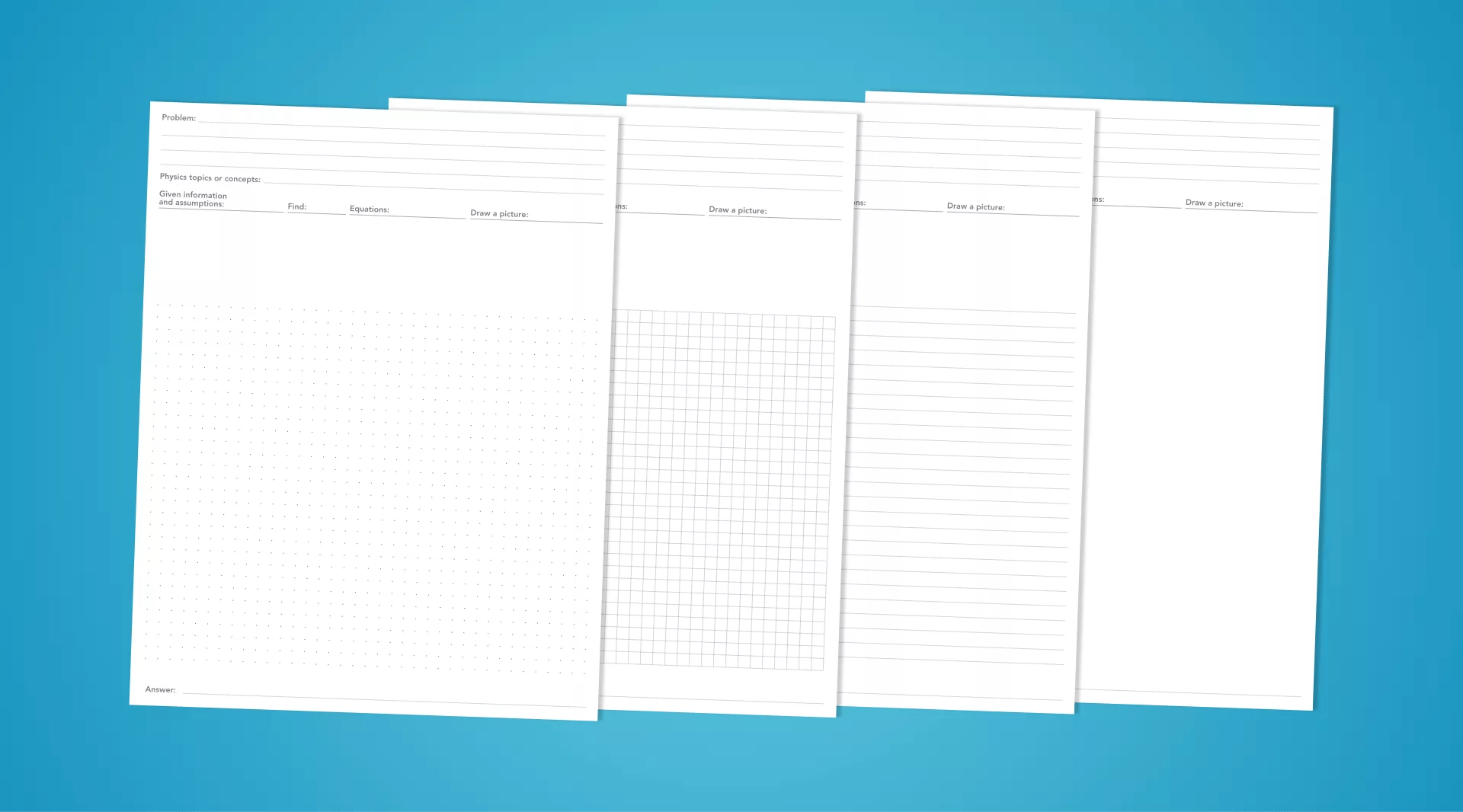How to Solve Physics Problems
Every physics problem is different but we can work through all of them using a similar method. Of course the concepts and equations that we'll need for each problem depend on the topics involved in the problem, but the general process for approaching problems is more or less the same for any topic.
Below is the problem solving method I try to follow when working on physics problems and it's what I recommend students use. There are many variations but they're all pretty similar. Start with this method and see what works best for you.

Choose a style and download or print these worksheets to use when you're solving physics problems.

- Make sure you know the basics - Algebra, geometry, trig, unit conversion and other basic concepts are key to solving physics problems. These basics may not be taught in the physics class itself, but you're expected to understand them. So be sure to go through the Basics section or find other resources to make sure you're up to speed.
- Make sure you understand the concepts and equations (maybe the most important point on this page) - The most common root cause of not knowing how to solve a problem is not really understanding the concept involved or what the equations mean. Too often, classes ask you to solve physics problems without mastering the fundamentals. It sounds obvious, but you need to know the physics before you can answer questions about it. When you fully understand a physics concept and have the equations in front of you, you'll immediately have an idea of how to solve most problems as soon as you read them.
- Keep your work organized - This may sound like obvious generic advice. But physics problems are hard enough, don't make them harder by getting confused from your own work. Many physics problems involve multiple equations, multiple directions, multiple objects and forces, and maybe even multiple parts to a question. Get enough paper so that you have plenty of room to work. If you mess something up, re-write some of your work instead of cramming it in and making things messy. As you work through a problem and rearrange / combine equations or plug in numbers, make sure your work is easy to follow and see how you got from point A to B. And of course, make sure to keep track of your units. If you don't want to write them in everywhere, make sure you're plugging in the correct SI units and you should get the correct SI units out.
- Practice - Solving a physics problem requires knowledge of the topic, but also: critical thinking skills, understanding what each problem is really asking you, imagining the situation and drawing a picture, extracting information from the word problem, and deciding which concepts and equations to apply. Some of these things will be new when starting physics, so just know that you'll get better if you practice solving problems.
- Solving multiple choice problems - Solve the problem as if there were no multiple choice answers given, and hopefully the answer you get is one of the options. If the answer you get is not an option, go back and check where you made a mistake. Primarily, multiple choice questions exist to make grading faster and easier, and not to change the way you would normally solve a problem. In fact, similar answers are often given to trick people who aren't paying attention. However if you check your work, try the problem several times and still don't get a matching answer, you can use clues from the answers given to help you - such as the units or general magnitude of the answers.
- Let algebra do the work for you - One thing that takes some getting used to is trusting that the algebra and the math will give you the right answer (as long as you set everything up correctly). When you correctly set up, combine and rearrange equations for a particular physics problem, what you have is one or more equations that mathematically represent the true physical relationships between the things in the problem. So when you correctly solve the algebraic equations and get the unknown variable that you want (your answer), you'll have to trust that this answer is right. This seems weird at first, because depending on how much math we did, we don't "feel" like we really understand how we got to that answer. But as long as we did everything correctly, the algebra will take care of the thinking for us. If there's time, we can review the work and find an intuitive way to explain why that answer makes sense.
More courses have been added to Physics Lab! Check them out on the home page.
You can find the courses that you signed up for in My Dashboard. You can access your dashboard by clicking "My Dashboard" at the top of the home page or in the left sidebar inside a course if you're logged in.
If you've signed up for a course before, you should receive an email in the next week or two with more details about the recent changes to the website.
If you have any questions, send me an email at chris@physicslab.app or a message on Discord @physicslab (Chris).
You can learn more about the issue here at Teachable Status.
